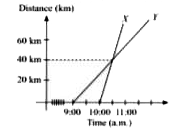Two friends X and Y start a journey at different times as shown in the graph. Which of the following statements is false regarding their motion?

A
X moves with uniform speed.
B
Y moves with uniform speed.
C
Both move with same speed.
D
Both meet at 10:30 a.m.
Video Solution
Text Solution
The correct Answer is:B
Rate of change of distance with time gives the speed of the object different for this. As X and Y, therefore they move with different speeds. However, throughout their motion they move with uniform speed. As the rate of change is greater for X, so speed of X is more than the speed of Y.
|
Updated on:21/07/2023
Topper's Solved these Questions
Similar Questions
Knowledge Check
- Question 1 - Select One
Which of the following statement is false regarding entropy?
AGreater the disorder in an isolated system, lower is the entropyBThe entropy change can be attributed to rearrangement of atoms or ions from the one pattern in the reactants to another (in the product)Cdecreases of regularity in structure would mean increase in entropyDThe gaseous state is the state of highest entropy - Question 2 - Select One
Which of the following statement is false regarding entropy?
AThe greater the disorder in an isolated system, the lower is the entropyBthe entropy change can be attributed to rearrangement of atoms or ions from one pattern in the reactant of another (in the product)CDecrease of regularity in structure would mean increase in entropyDThe gase ous state is the state of highest entropy - Question 3 - Select One
Which of the following statements is false regarding alkali metals
AAlkali metals are soft and can be cut with the help of knifeBAlkali metals do not occur in free state in natureCAlkali metal are highly electropositiveDAlkali metal hydrides are covalent in character.
Which of the following statements is false regarding predators ?
View SolutionWhich of the following statements is false regarding predators ?
View SolutionWhich one of the following statements is false regarding the vectors ?
View SolutionWhich of the following statements is false regarding alkali metals ?
View SolutionWhich of the following statements is false regarding the gravitational force ?
View Solution

